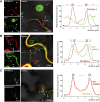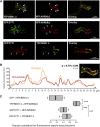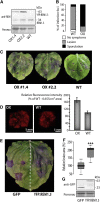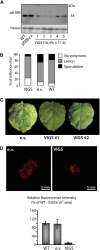The Plant Membrane-Associated REMORIN1.3 Accumulates in Discrete Perihaustorial Domains and Enhances Susceptibility to Phytophthora infestans
- PMID: 24808104
- PMCID: PMC4081318
- DOI: 10.1104/pp.114.235804
The Plant Membrane-Associated REMORIN1.3 Accumulates in Discrete Perihaustorial Domains and Enhances Susceptibility to Phytophthora infestans
Abstract
Filamentous pathogens such as the oomycete Phytophthora infestans infect plants by developing specialized structures termed haustoria inside the host cells. Haustoria are thought to enable the secretion of effector proteins into the plant cells. Haustorium biogenesis, therefore, is critical for pathogen accommodation in the host tissue. Haustoria are enveloped by a specialized host-derived membrane, the extrahaustorial membrane (EHM), which is distinct from the plant plasma membrane. The mechanisms underlying the biogenesis of the EHM are unknown. Remarkably, several plasma membrane-localized proteins are excluded from the EHM, but the remorin REM1.3 accumulates around P. infestans haustoria. Here, we used overexpression, colocalization with reporter proteins, and superresolution microscopy in cells infected by P. infestans to reveal discrete EHM domains labeled by REM1.3 and the P. infestans effector AVRblb2. Moreover, SYNAPTOTAGMIN1, another previously identified perihaustorial protein, localized to subdomains that are mainly not labeled by REM1.3 and AVRblb2. Functional characterization of REM1.3 revealed that it is a susceptibility factor that promotes infection by P. infestans. This activity, and REM1.3 recruitment to the EHM, require the REM1.3 membrane-binding domain. Our results implicate REM1.3 membrane microdomains in plant susceptibility to an oomycete pathogen.
© 2014 American Society of Plant Biologists. All Rights Reserved.
Figures









References
-
- Baxt LA, Garza-Mayers AC, Goldberg MB. (2013) Bacterial subversion of host innate immune pathways. Science 340: 697–701 - PubMed
-
- Benschop JJ, Mohammed S, O’Flaherty M, Heck AJ, Slijper M, Menke FL. (2007) Quantitative phosphoproteomics of early elicitor signaling in Arabidopsis. Mol Cell Proteomics 6: 1198–1214 - PubMed
-
- Bhat RA, Panstruga R. (2005) Lipid rafts in plants. Planta 223: 5–19 - PubMed
-
- Bos JI, Armstrong MR, Gilroy EM, Boevink PC, Hein I, Taylor RM, Zhendong T, Engelhardt S, Vetukuri RR, Harrower B, et al. (2010) Phytophthora infestans effector AVR3a is essential for virulence and manipulates plant immunity by stabilizing host E3 ligase CMPG1. Proc Natl Acad Sci USA 107: 9909–9914 - PMC - PubMed
LinkOut - more resources
Full Text Sources
Other Literature Sources

